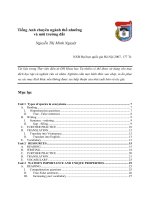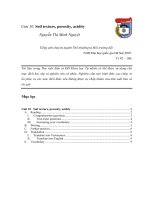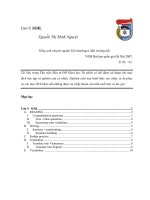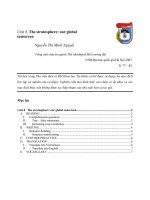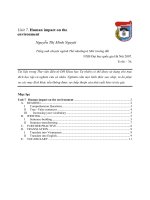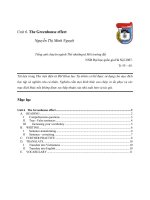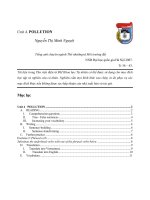English for industrial machinery and equipment(Tiếng anh chuyên ngành máy móc và thiết bị
Bạn đang xem bản rút gọn của tài liệu. Xem và tải ngay bản đầy đủ của tài liệu tại đây (2.56 MB, 65 trang )
HO CHI MINH CITY UNIVERSITY OF INDUSTRY
DEPARTMENT OF INDUSTRIAL MACHINERY AND EQUIPMENT
LY NGOC MINH, M.Eng
SPECIALIZED ENGLISH
FOR INDUSTRIAL MECHINERY
AND EQUIPMENT
(Mechanical Engineering, Heat Engineering -
Refrigeration, Industrial Machinery and Equipment)
TIẾNG ANH CHUYÊN NGÀNH
MÁY VÀ THIẾT BỊ
Tp Hồ Chí Minh, 2008
1
UNIT 1: METALS
A. UNDERSTANDING A PRINTED TEXT
This passage will give you some information about metals, alloys and their
uses. Notice how it is diveded into paragraphs and sections. Pay attention to the
headings.
Now look at the following questions:
1. What is the main advantage of metals?
2. Can plastics be recycled?
3. Which type of heat treatment makes metal softer and less brittle?
4. Why are Concorde’s engine surrounds made of titanium alloys?
Read the passage to find the answers. Remember that you do not need to
understand every word in order to do so.
USER
Why does man use metals still so much today when there are other materials,
especially plastics, which are available. A material is generally used because it
offres the required strength, and other properties, at minimum cost. Appearance is
also an important factor. The main advantage of metals is their strength and
toughness. Concrete may be cheaper and is often used in building, but even concrete
depends on its core of steel for strength.
PLASTIC
Plastics are lighter band more corrosion-resistant, but they are not usually as
strong. Another problem with plastics is what to do with them after use. Metal
objects can often be broken down and the metals recycled; plastics can only be
dumped or burned.
2
ALLOYS
Not all metals are strong, however. Copper and aluminium, for example, are
both fairly weak-but if they are mixed together, the result is an alloy called
aluminium bronze, which is much stronger than either pure copper or pure
aluminium. Alloying is an important method of obtaining whatever special
properties are required: strength, toughness, resistance to wear, magnetic properties,
high electrical resistance or corrosion resistance.
3
HEAT TREATMENT
The properties of a metal can be further improved by use of heat treatment.
Heat treat treatment is the term given to a number of different procedures in which
the properties of metals and alloys are changed. It usually consists of heating the
metal of alloy to a selected temperature below its melting point and then cooling it
at a certain rate to obtain those properties which are required. For example,
hardening is used to make metals harder. Tempering makes them softer and less
brittle. Annealing is carried out to make a metal soft so that it can be machined
more easily. In this-way, metallic materials can be produced to meet every kind of
engineering specification and requirement.
4
Heat
no.
SPECIAL ALLOYS
When Concorde was built, a material was needed which could withstand
extreme aerodynamic conditions and would have a life of a least 45,000 flying
hours. To achieve this, a special aluminium alloy was developed which is tough and
lightweight and is used in over 70% of Concorde’s structure. Another 16% is made
of high-strength steel, and titanium alloys are used in the engine surrounds to
withstand temperatures of 4000 degrees centigrade.
Methods of extracting, producing and treating metals are being developed all
the time to meet engineering requirements. This means that there is an enormous
variety of metals and metallic materials available from which to choose.
B. CHECK YOUR UNDERSTANDING
Now read the text carefully, looking up anything you do not understand in a
dictionary or reference book. While you read, look for the answers to these
questions:
1. Put T or F to indicate if the statements below are true or false according to
the facts in the passage.
• Concrete is a cheap building material.
• Plastics are more easily recycled than metals.
• Aluminium bronze is an example of alloy.
• Pure copper is stronger than the alloys that are made by mixing copper with
aluminium.
• Tempering is a kind of heat treatment.
• It is sometimes an advantage of a metal to be soft.
• Concorde is built mainly of steel.
2. Answer the following questions:
5
• In the paragraph 1, it is on line 2, which nouns does the pronoun ‘it’ refer to?
• In the paragraph 2, them is on line 8, which nouns does the pronoun ‘them’
refer to?
• In the paragraph 3, which is on line 13, what does the word ‘which’ refer to?
• In the paragraph 4, it is on line 19, what does the pronoun ‘it’ refer to?
• In the paragraph 4, its is on line 20, which noun or nouns does the word ‘its’
refer to?
• In the paragraph 4, it is on line 20, does the word ‘it’ refer to the same noun
as that at the beginning of the sentence?
C. INCREASE YOUR VOCABURLARY
1. New words:
• Resistance
• Annealing
• Specification
• Surrounds
• Centigrade
• Enorrnous
2. Properties of materials: These words and phrases refer to properties of
materials: strength, toughness, corrosion resitant. In the passage, there are nine
words which refer to properties of materails. Let list them.
3. Nouns and adjectives
4. Verbs that descirebe change “harnden” means to make something harder.
What words have the following meaning:
• To make something thicker
• To make something weaker
• To make something stronger
D.
CHECK YOUR GRAMMAR
1. Ac
tive and passive.
2. Comparatives and superlatives.
3.
Adverbs and adjectives.
6
UNIT 2: MEASUREMENT
A. UNDERSTANDING A PRINTED TEXT
This passage will introduce you to the principle of measurement in
different fields of engineering. Look at the way it is devided into sections and
paragraphs. Pay attention to the headings. Now look at these questions and read
the passage through to find the answers. Remember, you do not have to
understand every word in order to do so.
1. Are engineering projects possible without knowledge of measurement?
2. How many types of temperature measurement are given in the third
paragraph?
3. Do engineers need to know about all the different forms of measurement?
4. Do you know how many basic units is SI based on?
5. What instrument is used when measurering a fly wheel housing?
MEASUREMENT
THE IMPORTANCE OF MEASUREMENT
One definition. A Simple dictionary definition of the verb "to measure" is:
to find the size, quantity, volume, degree, weight, etc of something by means of
standard or unit, in all branches of engineering, measurement plays a vital role
since the design, manufacture and use of any product cannot be considered
without reference to this concept.
It is for this reason that the majority of texts on engineering contain tables,
charts, lists or appendixes which provide the student with accepted standards and
units of measurement.
7
Water level control
Float type
Positive Shutoff Valve
(Ball Valve)
Slow Opening Valve
“Throttling Valve”
(Gate Valve)
Connecting lines to boiler
should be straight runs
Piping must be pitched to drain
with no restrictions or reduction in
pipe size
Collapsed or crushed floats on high pressure
boiler applications can be prevented.
1. Follow installation tips shown
2. Use a dual valve system.
3. Open Ball Valve first.
4. Open ‘Throttling Valve’ slowly until drain
piping heats up and then open fully.
Crushed Floats
Standard Models
‘MD’ Models
Pump Off
Pump On
3/4” Differential
1 3/8” Differential 1 13/16” Differential
Switch setpoints at 150psi
Series 150/157 & Series 150S/157S
Operating Levels
8
TYPES OF MEASUREMENT
Knowledge of measurement. We are all familiar with the symbols C and
F for scales of temperature, but there is also K (Kevin), which is the fraction
(1/273) of the thermodynamic temperature of the triple part of water. Of course it
may not always be necessary to understand the precise definition itself, provided
one can understand the significance of the term or figure in relation to the
diagram, chart or calculation involved. Each branch of engineering, naturally,
tends to be more concerned with some particular forms of measurement than with
others.
DIFFERENT SYSTEMS
Conversion factors and SI equivalents. Look, for example, at Table 1
below taken from a text for chemical engineers and which shows conversion
factors. Then compare it with Table 2 which gives US customary units and their
SI equivalents and comes from a text on sanitation engineering. At first glance, it
may seem difficult or even impossible, to find any connection between the two.
However, if we look more closely, we will see that much of the information
shown deals with the same things but from a different approach. Clearly, students
in either of the engineering branches for which the texts were written would have
little difficulty in using the figures and symbols relating to their own
specialization.
9
10
THE BASIS OF SI
SI Units. SI is the abbreviation for Systeme International d'Unites. SI is
based on seven basic units, each of which is defined with great accuracy and from
which all other basic units are derived. Under the system each physical quantity
has only one particular unit for its measurement. Thus, a 30 length is only
measured in metres. If the number employed with a basic unit is very small, or
very large, then a prefix can be used as in km for kilometres. Conversion tables
are necessary because the USA and Britain still retain a measurement system
which is different from that used by the rest of the world.
THE NEED FOR TYPES OF MEASURING DEVICES
Measuring devices. Since measurement is so important, it follows that
there is a wide range of devices and instruments which are designed to indicate
very precisely length, pressure, time and so on. The illustration below, from a
manual on diesel mechanics, with its instructions for aligning and measuring a
flywheel housing, shows one such device and some of the language and figures
associated with its use.
B. CHECK YOUR UNDERSTANDING
Read the text again carefully, looking up anything you do not understand in
a dictionary or reference book. Then answer the following questions:
1. What is measurement?
11
2. How many different symbols for measurement of length are shown in the
two tables?
3. How is the US measurement of force different from the SI unit?
4. Why do you think flow, concentration and velocity are in table 2 but not in
table 1?
5. What is the principle on which SI is based?
6. What is the US customary unit for the SI equivalent 1.356 J?
7. How many “ins” are there in 1”m”, according to Table 1?
8. In the instructions on flywheel alignment, does 90
0
refer to temperature or
distance?
C. INCREASE YOUR VOCABULAY
Find the symbols in table 1 and 2 which match the works:
1. Joule
2. Inch
3. Mile
4. Watt
5. Horse power
6. Kilogram
7. Miles per second
8. Pounds per square foot
9. Cubic metre
10. Milligrams per liter
D. CHECK YOUR GRAMMAR
Defining. Example: A thermometer is an instrument / used for measuring
tempearature / which is used to measure temperature / which measures
temperature.
12
UNIT 3: DESIGN AND FUNCTION
A. UNDERSTANDING A PRINTED TEXT
This text gives you some information about the design
and function of filters in diesel systems. Remember to
look at the notes in he margins for quick reference and
notice how the text is divided into paragraphs of
different lengths. Pay attention to the diagrams and
labels.
Try to answer the following questions after the first reading. Remember,
you do not have to understand every word in the text to do so.
1. What is the function of a filter?
2. How many classes of filter materials are mentioned?
3. Which materials are only used for the exhaust system?
4. How many basic types of filter are used?
5. Which type of filter is used mainly for the lubrication and fuel-injection
systems?
TEXT: FILTERS FOR DIESEL SYSTEMS
The need for filters in systems
1. The most common cause of engine trouble is contaminants in the system;
therefore, the most sensible way to maintain and preserve a high-performance
hydraulic system is simply to keep the system clean. Many different types of
filters are manufactured to accommodate the various types of hydraulic systems.
Filters are a lifeline because they remove contaminants and thus protect the
systems. The manufactures originally install the filters, strainers and breathers.
They also provide service manuals with precise instructions in order to ensure
trouble free operation of the system components. Nevertheless, foreign matter
enters the system usually through careless or inadequate maintenance, or through
normal wear of the components within the system.
13
Materials used in filter elements
2. There are three classes of filter materials: mechanical, inactive absorbent
and active absorbent. The mechanical filter consists of closely woven metal
screens or metal disks. It generally removes only fairly coarse insoluble particles.
3. Inactive absorbent filter are composed of materials such as cotton, yarn,
cloth, impregnated cellulose paper, or porous metal. They will remove quite small
particles and some types even remove water and water-softener contaminants.
The elements often are treated to give them an affinity to the contaminants found
in the system.
4. Active absorbent filter materials, such as charcoal or Fuller earn, remove
particles by absorption as well as by filtering. They are not used as litter material
for the lubrication or fuel-injection systems. They are, however used as a filter
material for the exhaust system.
14
Measurement of filter effectiveness
5. The unit of measurement for determining the effectiveness of a filter is the
micrometer (μm) (old term: micron). One micrometer is equal to 0.000039 inch (1
μm = 0.000039 in), or in metric units of measurement, 0.000001 meter (1 μm =
0.000001 m). When new and clean, a filter will prevent a specific percentage of
particles measuring a specific minimum size from entering the fluid.
6. Four basic types of filters are used: screen and trainer, surface type, deep
type, and edge type. The type, size and micrometer rating is dictated by the
system itself.
7. SCREENS AND STRAINER. Screens and trainers are surface – type
filters and sometimes are referred to as mechanical filters. These inlet screens
prevent large foreign particles from entering the system. They are classified
according to a sieve number which relates to the micrometric rating.
8. SURFACE - TYPE FILTER. The surface-type filter element shown in
Fig. d is composed of a specially treated micrometric cellulose paper. The paper
is formed in vertical convolutions (wrinkles) and in a cylindrical pattern. It is
reinforced on the inside and outside and is equipped with a seal on the top and the
bottom. Sometimes multifolded paper elements are used.
15
9. DEEP TYPE FILTER. The design of the deep-type filter is quite
different from that of the surface filter (Fig. b). It is more efficient and has a
longer service life. Fig. e shows two types of filter materials and illustrates the
substantial depth of the filter material
10. Deep-type filters of porous materials consist of fine woven copper of
cinder bronze elements formed to fit the filter housing (Fig. c). They can also be
made of minute stainless steel balls joined as one inflexible piece.
11. EDGE – TYPE FILTER. Edge-type filters are used as primary filters for
the lubrication and fuel-injection systems. In this deign, many copper, bronze,
papers, or steel disks are positioned over the center tube. The tube acts as a
`hydraulic line and directs oil to the outlet port. Some edge-type filters have the
added convenience of the automatic scrapper of a hand-operated scrapper for
cleaning the outside of the disk. This, of course, helps to expend the life of the
filter.
16
12. Regardless of the design or the type of the filter element is sealed in a
housing. O rings or gaskets separate the filtered from the unfiltered liquid. Liquid
enters near the top of the filter housing or, with a screw-on-type oil in the fuel
filter, it enters via the adapter plate and flows into the outer area of the filter
element. The system pressure force the liquid through the filter element into the
center area. Filtered liquid the pass through the center and on the outlet port.
Some filter designs incorporate an antidrain check valve to prevent fluid from
draining from the filter bowl when the engine is stopped. This ensures instant oil
or fuel pressure when restarting.
13. Full - flow oil filters have either a built - in bypass valve or a bypass valve
which is mounted separately. The purpose of the bypass valve is to bypass oil
ensuring lubricant to the system in the event that the filter element becomes
plugged. A bypass valve is also used in oil cooler for the same purpose.
17
B. CHECK YOUR UNDERSTANDING
Read the text again carefully, looking up anything you do not understand in
a dictionary or reference book. Then do the following exercises.
1. By reference to the text, answer these questions
• What Figure references should the letters below the illustrations indicate?
• Which type of filter is not illustrated here?
• What exactly does Fig. 22-6 illustrate?
• What are two causes of contaminants in a system?
• Can filters prevent all particles from entering a system?
• What is the connection between Screens and Strainers and Surface-Type
filters?
• Which type of filter can use metal or paper elements?
• What feature is common to all filter elements?
2. What do the following bold – italic words refer to
• Paragraph 1: they
• Paragraph 2: it
• Paragraph 4: they
• Paragraph 8: it
• Paragraph 11: this
• Paragraph 12: this
3. Are the sentences below True (T) or False (F) according to the information
given in the text?
• Engine trouble is often caused by contaminants in the system. □
• All inactive absorbent filters can remove water. □
• Charcoal is a material used in active absorbent filters. □
• A micron and a micrometer indicate the same unit of measurement. □
•
Mechanical filters are different from
surface-type filters. □
• Disks in edge-type filters are made of paper. □
18
C. INCREASE YOUR VOCABOLARY
Using the dictionary if necessary, complete the following exercises.
1. Say what words are used in the first paragraph to mean:
• To be suitable to
• Accurate and detailed steps in maintenance
• Parts which go to together to make up a system
2. In paragraph 2, 3, 4, find two verbs which can mean “to be made up of
“.
3. Explain in your own words the meaning of the following phrases,
which occur in the first four paragraphs:
• A high - performance hydraulic system
• Water – soluble contaminants
• Fuel – injection system
4. Say which words in paragraphs 6 -11 have the opposite meanings to
the following:
• Allow
• Horizontal
• Inefficient
• Non – porous
• Very large
• Reduce
5. New vocabularies:
• Particles
• Preserve
• Strainer
• Vertical
• Convolutions
• Cylinclrical
• Multifold
• Incorporate
D. CHECK YOUR GRAMMAR
1. Prepositions denoting location and movement.
2.
Indefinite and definite articles.
3.
Expressing design and function.
19
UNIT 4: ENERGY, HEAT AND WORK
A. UNDERSTANDING A PRINTED TEXT
The following text will give you some information about types and sources
of energy. It will also explain briefly how energy may be converted to work. Note
the paragraph organization and refer to the headings for quick reference. Now
look at these questions:
1. What is the type of energy created by movement?
2. What type of energy depends upon position?
3. What type of energy comes from the sun?
4. What are the three most important sources of power?
5. Give an example of a heat engine.
Read the passage and find the answers to these questions. It is not
necessary to understand every word to do this.
TEXT: ENERGY, HEAT AND WORK
WHAT IS THE ENERGY?
1. Energy may be thought of as that property of something which enables it to
do work. When we say that something possesses energy, we suggest that it is
capable in some way of exerting a force on something else and performing work
on it. When work is done on something, on the other hand, energy has been added
to it. Energy is measured in the same units as those of work, the foot-pound and
the Joule.
20
Steam power plant
Heat
• Heat is the energy
transferred between a
hot object and a cold
object.
•Temperatureis the
degree of “hotness” of
an ob
ject.
q
T
high
T
low
Work
• Work is any energy
exchange that is not
heat.
• Work is any interaction
that could have as the
sole effect the raising of a
weight.
• Work = force · distance
1 kg
1 meter
21
KINETIC ENERGY
2. Energy occurs in several forms. A familiar example is the energy a moving
body possesses by virtue of its motion. Every moving object has the capacity to do
word. By striking another object that is free to move, the moving object can exert
a force and cause the second object to shift its position. It is not necessary that the
moving object actually do work; it may keep on moving or friction may slowly
bring it to a stop. But while it is moving, it has the capacity for doing work. It is
this specific property that defines energy, since energy means the ability to do
work, and so all moving things have energy by virtue of their motion. This type of
energy is called kinetic energy.
POTENTIAL ENERGY
3. The statement that energy is the capacity something has to do work is not
restricted to kinetic energy but is perfectly general. Many objects possess energy
because of their position. Consider a pile driver, a simple machine that lifts a
heavy weight (‘the hammer’) and allows it to fall on the head of a pile, thereby
driving the pile into the ground. When the hammer has been lifted to the top, it
has only to be released to fall and do work on the pile. The capacity for doing
work is present in the hammer as soon as it has been lifted, simply because of its
position several feet above the ground. The actual word on the pile is done at the
expense of kinetic energy gained during the hammer’s fall, but the capacity for
working is present before the fall starts. Energy of this sort, depending merely on
the position of an object, is called potential energy.
ENERGY SOURCES
4. Prior to the development of nuclear, all the significant contributions to the
mechanical energy used by man had the sun as their source. However,
economical methods have not been developed as yet for directly converting solar
radiation into work on a large scale. The amount of energy striking the earth from
the sun is staggering when considered as a whole, but per unit surface the
quantity is small. This introduces the serious difficulty of concentrating the heat
22
gathered from a large surface and using it as a source for conversion to work
.Significant research on this difficulty is underway, and progress has been made
on the related problem of the use of solar energy directly as heat; for example,
solar radiation is being used to heat homes, to produce high temperatures for
metallurgical operations (solar furnaces), and to concentrate aqueous solutions by
evaporation.
CONVERTING ENERGY TO WORK
5. The kinetic energy due to the mass movement of air has been used to some
extent for the production of work, especially in rural areas (windmills). Variations
and uncertainties in wind velocity and the necessity for large-sized equipment to
produce significant quantities of work, are problems retarding progress in this
field.
6. Conceivably, the available potential energy of tides could be concentrated
and utilized. Attempts in this direction on a large scale have been made in parts of
the world where tides are extreme. However, the total power production in this
manner is unlikely to be highly significant in comparison with world demands for
energy.
ENERGY AS HEAT FOR WORK
7. By far the most important sources of power are the chemical (molecular)
energy of fuels, nuclear energy, and the potential energy of waterfalls. The use of
water power involves the transformation of mechanical energy from one form to
another; hence, 100 percent efficiency is theoretically possible. On the other
hand, all present-day methods for the large-scale use of molecular and nuclear
energy are based on the heat into useful work. Accordingly, the efficiency of all
such processes is destined to be low (values greater than 30 percent are
uncommon), despite improvements in the design of equipment. This is, of course,
a direct consequence of the second law of thermodynamics which states that heat
cannot be converted into work unless some of the heat is transferred from a
higher to a lower temperature.
23
FUEL CELLS
8. If some means could be devised to convert the energy in fuels into work
without the intermediate generation of heart, conversion efficiency could be
considerably improved. The usual device for the direct use of chemical energy is
the electrolytic cell, in which the conversion is to electrical energy. Progress has
been made in developing cells which operate on hydrogen and on carbonaceous
fuels such as natural gas or coal. Such fuel cells are already in use to supply
modest power requirements for special purposes. The efficiency of these cells
ranges from 65 to 80 percent, about twice the value obtained by the conventional
process of first converting the chemical energy into heat.
9. In a conventional power plant the molecular energy of the fuel is released
by a combustion process. The function of the work-producing device is to convert
part of the heat of combustion into mechanical energy. In a nuclear power plant
the fission process releases the energy of the nucleus of the atom as heat, and
then this heat is partially converted into work.
HEAT ENGINES
10. In one form of heat energy, the working fluid is completely enclosed and
goes though a cyclical process, accomplished by vaporization and condensation.
Heat is transferred to the fluid from another part of the apparatus across a
physical boundary. A coal-fired power plant with steam as the working fluid is an
example. Here, the combustion gases are separated from the steam by the boiler-
tube walls. The internal-combustion of heat within the work-producing device.
Examples of this type are the Otto engine and the combustion gas turbine.
24
Power plant with steam

